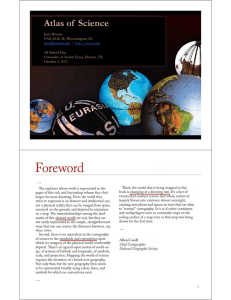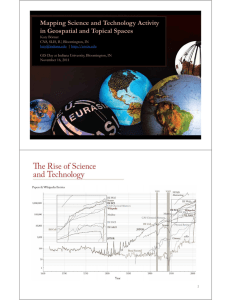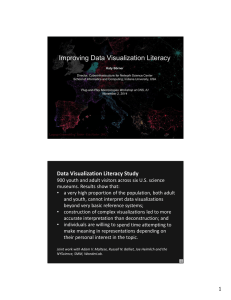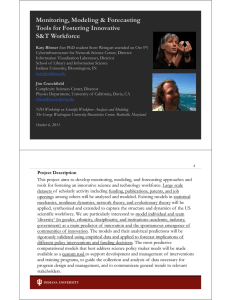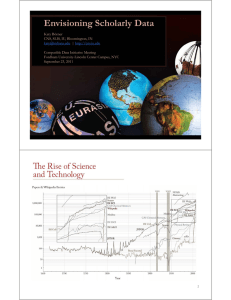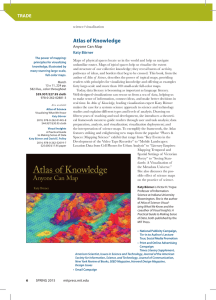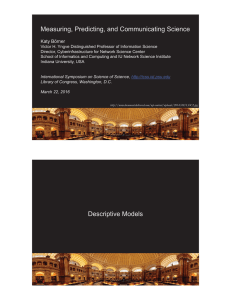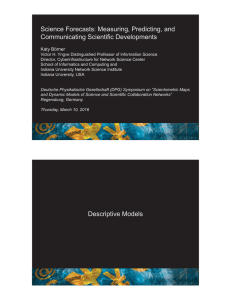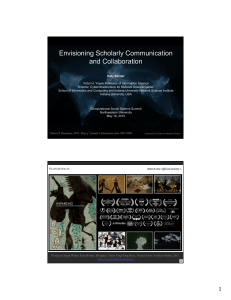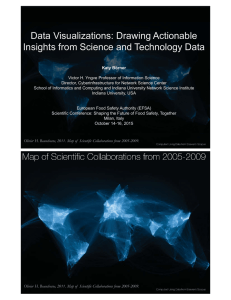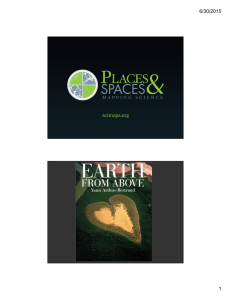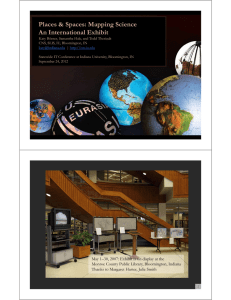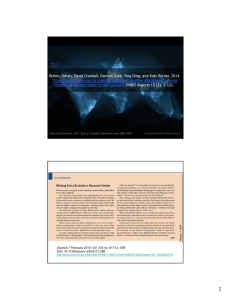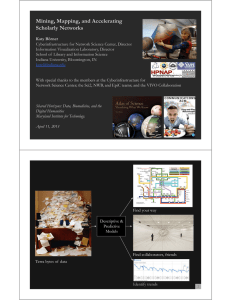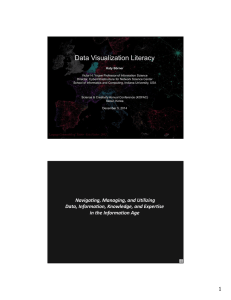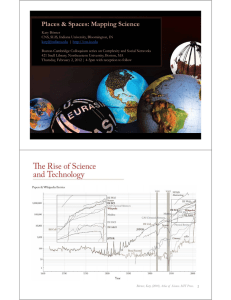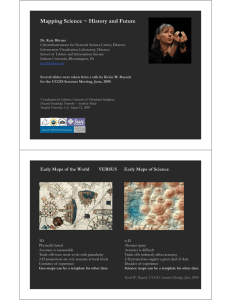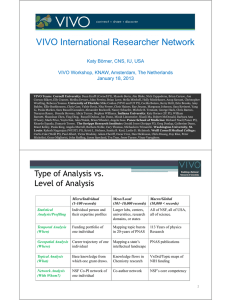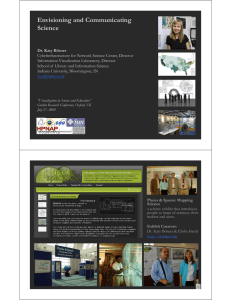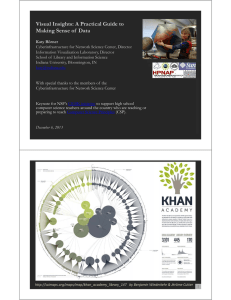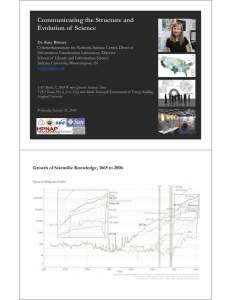The Use of Knowledge Mapping in International STI Horizon Scanning
advertisement
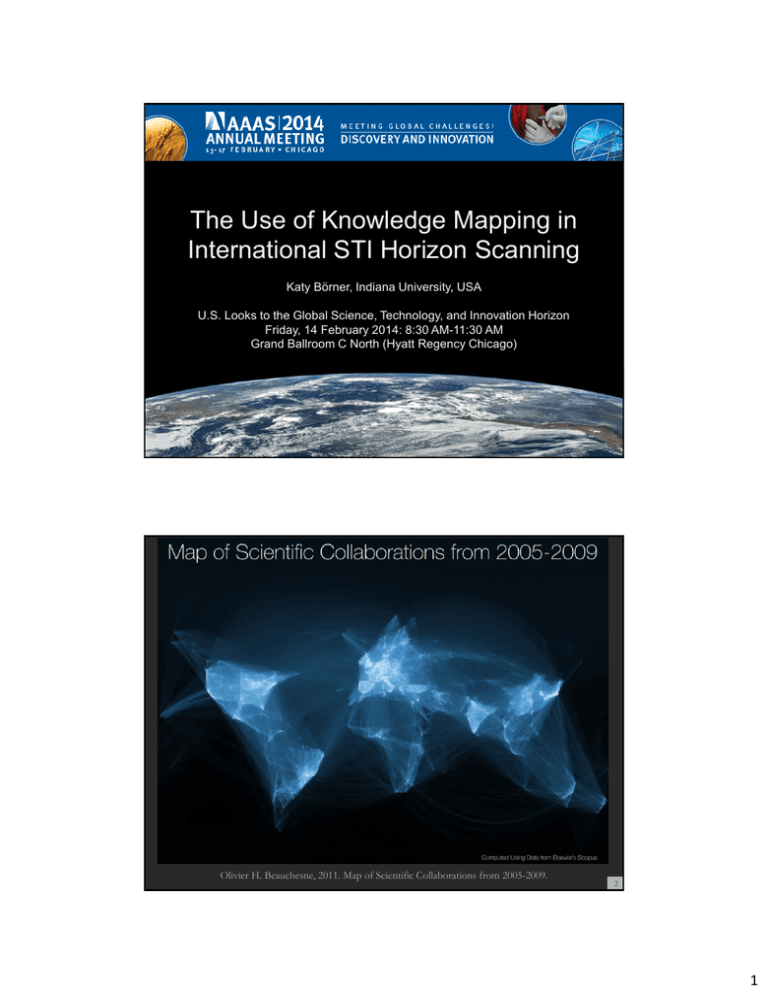
The Use of Knowledge Mapping in International STI Horizon Scanning Katy Börner, Indiana University, USA U.S. Looks to the Global Science, Technology, and Innovation Horizon Friday, 14 February 2014: 8:30 AM-11:30 AM Grand Ballroom C North (Hyatt Regency Chicago) Olivier H. Beauchesne, 2011. Map of Scientific Collaborations from 2005-2009. 2 1 Bollen, Johan, Herbert Van de Sompel, Aric Hagberg, Luis M.A. Bettencourt, Ryan Chute, Marko A. Rodriquez, Lyudmila Balakireva. 2008. A Clickstream Map of Science. 3 114 Years of Physical Review - Bruce W. Herr II, Russell Duhon, Katy Borner, Elisha Hardy, Shashikant Penumarthy - 2007 2 Council for Chemical Research. 2009. Chemical R&D Powers the U.S. Innovation Engine. Washington, DC. Courtesy of the Council for Chemical Research. 5 Science & Technology Outlook: 2005-2055 - Alex Soojung-Kim Pang, David Pescovitz, Marina Gorbis, Jean Hagan 2006 3 Places & Spaces: Mapping Science Exhibit scimaps.org 7 Brain Circulation International Comparative Performance of the UK Research Base – 2011. A report prepared for the Department of Business, Innovation and Skills. 4 Spatio-Temporal Information Production and Consumption of Major U.S. Research Institutions Börner, Katy, Penumarthy, Shashikant, Meiss, Mark and Ke, Weimao. (2006) Mapping the Diffusion of Scholarly Knowledge Among Major U.S. Research Institutions. Scientometrics. 68(3), pp. 415-426. Research questions: 1. Does space still matter in the Internet age? 2. Does one still have to study and work at major research institutions in order to have access to high quality data and expertise and to produce high quality research? 3. Does the Internet lead to more global citation patterns, i.e., more citation links between papers produced at geographically distant research instructions? Contributions: • Answer to Qs 1 + 2 is YES. • Answer to Qs 3 is NO. • Novel approach to analyzing the dual role of institutions as information producers and consumers and to study and visualize the diffusion of information among them. 9 The Global 'Scientific Food Web' Mazloumian, Amin, Dirk Helbing, Sergi Lozano, Robert Light, and Katy Börner. 2013. "Global Multi-Level Analysis of the 'Scientific Food Web'". Scientific Reports 3, 1167. http://cns.iu.edu/docs/publications/2013-mazloumian-food-web.pdf Contributions: Comprehensive global analysis of scholarly knowledge production and diffusion on the level of continents, countries, and cities. Quantifying knowledge flows between 2000 and 2009, we identify global sources and sinks of knowledge production. Our knowledge flow index reveals, where ideas are born and consumed, thereby defining a global ‘scientific food web’. While Asia is quickly catching up in terms of publications and citation rates, we find that its dependence on knowledge consumption has further increased. 10 5 Collective Allocation of Science Funding as an Alternative to Peer Review Bollen, Johan, David Crandall, Damion Junk, Ying Ding, and Katy Börner. 2014. "From funding agencies to scientific agency: Collective allocation of science funding as an alternative to peer review". EMBO Reports 15 (1): 1-121. http://embor.embopress.org/content/early/2014/01/07/embr.201338068 Contribution: We propose and validate a highly decentralized funding system. The system operates by giving all scientists an unconditional, equal amount of funding each year; scientists are required to donate a given percentage of their total funding to other scientists whom they feel would make best use of the money. The proposed system requires a fraction of the costs associated with peer review, but has been shown to yield comparable results. 12 6 Science 7 February 2014: Vol. 343 no. 6171 p. 598 DOI: 10.1126/science.343.6171.598 http://www.sciencemag.org/content/343/6171/598.full?sid=4f40a7f0-6ba2-4ad8-a181-7ab394fe2178 Illuminated Diagram Display on display at the Smithsonian in DC. http://scimaps.org/exhibit_info/#ID 14 7 15 Science Maps in “Expedition Zukunft” science train visiting 62 cities in 7 months 12 coaches, 300 m long Opening was on April 23rd, 2009 by German Chancellor Merkel http://www.expedition-zukunft.de 16 8 Find your way Information Technology Find collaborators, friends Terra bytes of data Identify trends 17 Börner, Katy. (March 2011). Plug-and-Play Macroscopes. Communications of the ACM, 54(3), 60-69. Video and paper are at http://www.scivee.tv/node/27704 18 9 Register for free at http://ivmooc.cns.iu.edu. Class restarted on Jan 28, 2014. 19 References Börner, Katy, Chen, Chaomei, and Boyack, Kevin. (2003). Visualizing Knowledge Domains. In Blaise Cronin (Ed.), ARIST, Medford, NJ: Information Today, Volume 37, Chapter 5, pp. 179-255. http://ivl.slis.indiana.edu/km/pub/2003borner-arist.pdf Shiffrin, Richard M. and Börner, Katy (Eds.) (2004). Mapping Knowledge Domains. Proceedings of the National Academy of Sciences of the United States of America, 101(Suppl_1). http://www.pnas.org/content/vol101/suppl_1/ Börner, Katy, Sanyal, Soma and Vespignani, Alessandro (2007). Network Science. In Blaise Cronin (Ed.), ARIST, Information Today, Inc., Volume 41, Chapter 12, pp. 537-607. http://ivl.slis.indiana.edu/km/pub/2007-borner-arist.pdf Börner, Katy (2010) Atlas of Science. MIT Press. http://scimaps.org/atlas Scharnhorst, Andrea, Börner, Katy, van den Besselaar, Peter (2012) Models of Science Dynamics. Springer Verlag. Katy Börner, Michael Conlon, Jon Corson-Rikert, Cornell, Ying Ding (2012) VIVO: A Semantic Approach to Scholarly Networking and Discovery. Morgan & Claypool. Katy Börner and David E Polley (2014) Visual Insights: A Practical Guide to Making Sense of Data. MIT Press. 20 10 All papers, maps, tools, talks, press are linked from http://cns.iu.edu CNS Facebook: http://www.facebook.com/cnscenter Mapping Science Exhibit Facebook: http://www.facebook.com/mappingscience 21 11
![Science Maps Explore New Ways of Displaying Information [Slide Show]](http://s2.studylib.net/store/data/010768709_1-3220b04c018450634153c8bae5b4b731-300x300.png)
